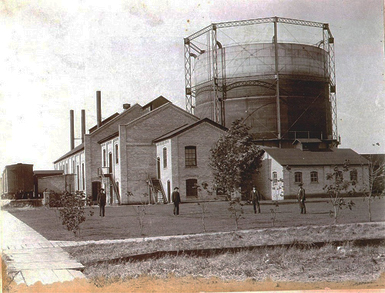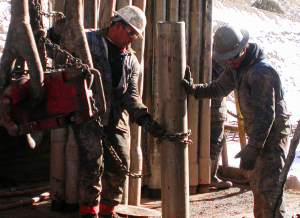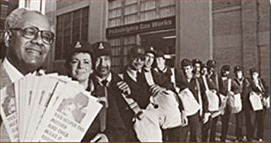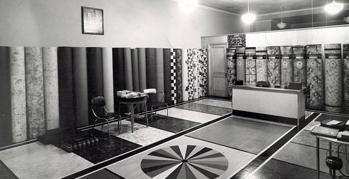Serving Philadelphia for More Than 180 Years
Since 1836, Philadelphia Gas Works (PGW) employees have dedicated themselves to serving Philadelphia 24 hours a day, 365 days a year in the coldest of winter days and the hottest of summer months. We thank our customers, current and former employees, and stakeholders for helping us become the essential green utility for the residents and businesses of Philadelphia.
1800's
 February 8, 1836 – Forty-six natural gas lights along Philadelphia’s Second Street are lit for the first time by employees of the newly formed Gas Works.
February 8, 1836 – Forty-six natural gas lights along Philadelphia’s Second Street are lit for the first time by employees of the newly formed Gas Works.
1836 – Philadelphia becomes the nation’s center for finance and industry. Matthias W. Baldwin, a former watchmaker, builds his Old Ironsides locomotive for the Philadelphia, Germantown and Norristown Railroad.
1856 – PGW completes the construction of a new natural gas holder at the company’s Point Breeze Plant in South Philadelphia. At this time, it is the largest in the nation with a total holding capacity of 1.8 million cubic feet of natural gas.
1877 – The American Centennial Exposition in Fairmount Park displays the wonders of the age in agriculture, horticulture and machinery. Natural gas cooking is showcased as a novelty, and 60 miles of pipe supply natural gas for the exhibition’s lights.
1897 – The United Gas Improvement Company signs a 30-year contract with the City of Philadelphia to manage PGW.
Early 1900's
 1902 – Natural gas begins to replace coal as the region’s favorite cooking fuel. PGW heavily promotes the new technology, selling up to 500 hundred ranges, priced at $23.50, a day.
1902 – Natural gas begins to replace coal as the region’s favorite cooking fuel. PGW heavily promotes the new technology, selling up to 500 hundred ranges, priced at $23.50, a day.
1926 – PGW helps the City of Philadelphia become one of the first cities in the United States to actively replace coal-fired hot water heaters with heaters powered by natural gas.
1926 – A three-person Gas Commission is created to regulate PGW.
1932 – The Girl Scouts of America bake and sell their very first cookies in the windows of the Philadelphia Gas and Electric Company’s Arch Street location, which later becomes part of PGW.
1945 – The single-point ignition range is developed in PGW’s laboratory, a first for the industry, to give thousands of customers the ability to conveniently light their burners.
1950 – With natural gas refrigeration gaining favor, PGW becomes the first U.S. utility to operate a refrigerator repair shop.
1955 – The matchless range rises in popularity, and the Northern Liberties Gas Company becomes the last of ten independent gas entities to merge with PGW.
1960's / 1970's
 1960 – The Philadelphia Eagles beat the Green Bay Packers at Franklin Field to win the NFL Championship.
1960 – The Philadelphia Eagles beat the Green Bay Packers at Franklin Field to win the NFL Championship.
1963 – The last 24 gas street lights on Independence Mall—in addition to 1.64 million customer appliances—are converted in six months to burn today’s version of natural gas.
1967 – PGW continues its stellar record of safety, marking 1,000,000 more work hours without a lost time accident.
1970s – PGW begins constructing two, twelve-story Liquefied Natural Gas (LNG) storage tanks at the company’s Richmond Plant. Today, they remain among the country’s largest.
1972 – The Philadelphia Facilities Management Corporation (PFMC) is created as a nonprofit corporation to operate and manage PGW under a contract with the City of Philadelphia.
1974 – The Philadelphia Flyers win their first National Hockey League Stanley Cup Championship with a 1-0 victory over the Boston Bruins.
1976 – Philadelphia, which was christened the nations’ birthplace with the signing of the Declaration of Independence in 1776, grabs national attention as the U.S. commemorates its bicentennial.
1980's
1980 – The Philadelphia Phillies defeat the Kansas City Royals 4-2 in a best-of-seven World Series at Veterans Stadium to win the club’s first championship.
1983 – The Philadelphia 76ers win their second NBA Championship by sweeping the Los Angeles Lakers four games to zero.
1983 – PGW wins the American Gas Association’s Merit Award for helping to start the Utility Emergency Services Fund, which assists low income customers in paying their utility bills.


The New Millenium & Today
 2000 – The Marcellus Shale formation, which stretches from New York to West Virginia, begins to be widely explored, doubling the country’s known reserves of natural gas while lowering and stabilizing the cost of natural gas for years to come.
2000 – The Marcellus Shale formation, which stretches from New York to West Virginia, begins to be widely explored, doubling the country’s known reserves of natural gas while lowering and stabilizing the cost of natural gas for years to come.
2004 – The Philadelphia Eagles beat the Atlanta Falcons 27-10 to advance to the Super Bowl for the first time in 24 years.
2005 – Hurricanes Rita and Katrina slam into the Gulf Coast of the U.S., disrupting the lives of millions of Americans, causing billions of dollars in damage and spiking natural gas prices to record highs.
2007 – The Comcast Center surpasses One Liberty Place to become the city’s tallest building, also making Philadelphia one of only four American cities with two or more buildings over 900 feet.
2008 – The Philadelphia Phillies defeat the Tampa Bay Rays in five games to win their second World Series title.
2009 – PGW launches Pennsylvania’s largest natural gas energy conservation program to help 100,000 customers become more energy efficient.
2010 – PGW wins the American Public Gas Association’s prestigious Marketing and Sales Award and is named for the second time as one of 2010’s best diversity companies by the Diversity/Careers in Engineering and Information Technology magazine.
2011 – Under the leadership of David M. Seltzer, Chairman of the Board; Thomas E. Knudsen, President and Chief Executive Officer; and Craig E. White, Executive Vice President and Acting Chief Operating Officer, PGW begins 2011 with no short-term borrowed funds, collecting 98 cents of every dollar billed, with re-engineered Field Operations and Customer Service Departments generating over $20 million of cost savings and revenue enhancements.

